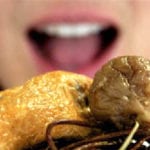 Weird Stuff
Weird Stuff  Weird Stuff
Weird Stuff  Mysteries
Mysteries 10 Tragic Disappearances and Deaths in Joshua Tree National Park
 History
History 10 Ways Childhood Really Sucked in the Old West
 Music
Music 10 Name Origins of Famous Bands from the 1990s
 Religion
Religion 10 Biggest Turnarounds by the Catholic Church
 Weird Stuff
Weird Stuff 10 Unbelievable Times Laws Had Unintended Consequences
 Humans
Humans Ten Historic Women Who Deserve Way More Credit Than They Got
 Movies and TV
Movies and TV 10 Films That Spawned Major Lawsuits
 History
History Ten Times Towns Were Wiped Off the Face of the Earth
 Creepy
Creepy 10 of the Most Disturbingly Haunted Public Houses in the UK
 Weird Stuff
Weird Stuff 10 Niche Subcultures That Are More Popular Than You Might Think
 Mysteries
Mysteries 10 Tragic Disappearances and Deaths in Joshua Tree National Park
 History
History 10 Ways Childhood Really Sucked in the Old West
Who's Behind Listverse?

Jamie Frater
Head Editor
Jamie founded Listverse due to an insatiable desire to share fascinating, obscure, and bizarre facts. He has been a guest speaker on numerous national radio and television stations and is a five time published author.
More About Us Music
Music 10 Name Origins of Famous Bands from the 1990s
 Religion
Religion 10 Biggest Turnarounds by the Catholic Church
 Weird Stuff
Weird Stuff 10 Unbelievable Times Laws Had Unintended Consequences
 Humans
Humans Ten Historic Women Who Deserve Way More Credit Than They Got
 Movies and TV
Movies and TV 10 Films That Spawned Major Lawsuits
 History
History Ten Times Towns Were Wiped Off the Face of the Earth
 Creepy
Creepy 10 of the Most Disturbingly Haunted Public Houses in the UK
10 More Animals People Eat Alive
When it comes to food, there are generally two types of people. Some like to stick with what they know, ordering the same food from the same places every time, while others like to seek adventure and try new things.
Part of that adventure is the fact that you can end up with some strange, sometimes just downright scary, dishes. Below are examples of live animals you could find in front of you if you let yourself venture into the dining extremes.
10 San Zhi Er
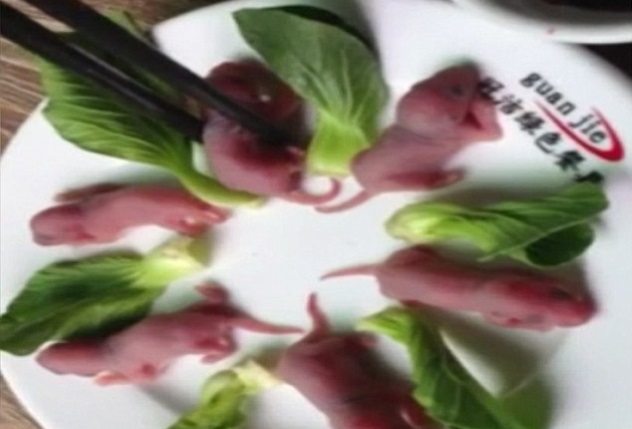
While you might be inclined to run and call the health inspector if you were to spot mice in a restaurant, not everyone feels the same way. For some, those mice are exactly the reason they went there in the first place.
Although it’s not a particularly common dish, some residents of the Guangdong province in China like to indulge in a relatively unknown specialty: newborn mice.[1]San zhi er, which translates as “three squeaks,” is a meal where baby mice are served live with a dipping sauce. The name derives from the three squeaks the mice will make during the meal: the first when they are picked up, the second when they are dipped, and the third when the diner bites down.
9 Fish Bucket Soup
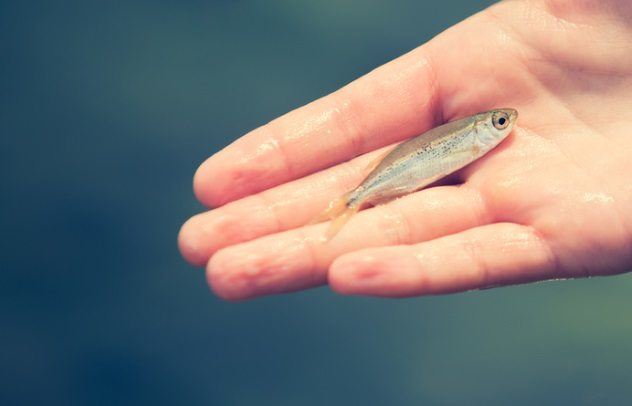
If mice aren’t your cup of tea, don’t worry. There are other animals you can dip in sauce and eat alive. Another option that is easier to make and more suitable for social occasions is to grab a bucket of live fish and a bowl of soup.[2]
This technique made a bit of a stir last year, when a video surfaced showing several people sitting around a bowl of soup. Using chopsticks, they lean over to pluck a live fish out of the bucket, before tossing it in the soup, where it splashes around before being eaten. The video is believed to have been shot in Southern China, based on the Cantonese that can be heard in the background.
8 Monkey
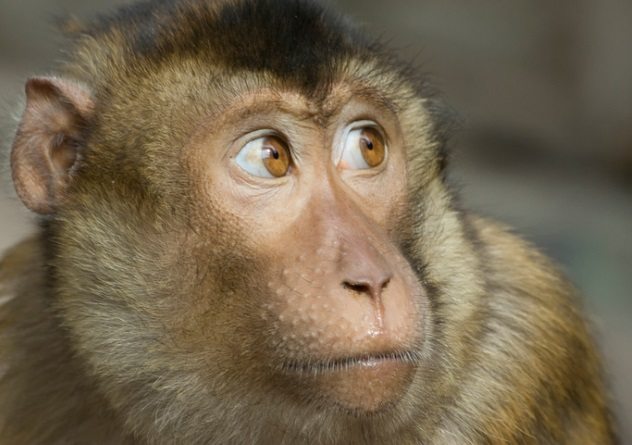
You may not think of monkeys as a source of food, but for many people around the world, eating monkey is akin to eating chicken. Most of these people can be found in isolated forest communities, such as those in the Amazon rain forest, where monkeys are just as common as any other animal. But even if a community sees no problem with eating monkeys, you’d think the vast majority of people would have a problem with eating them alive. But not all.
Macaques are extremely common in Cambodia, with the lowest possible conservation status ranking (least concern). This may explain why people have no problem eating them, but it does little to explain why they feel the need to eat the brains out of the still-living animal’s skull.[3]
Macaque brain is a delicacy in Cambodia, and the fresher the meat, the better. For this reason, macaques can be drugged or tied up, before having the tops of their heads cut off. They are then placed beneath a table with a specially carved hole for the monkey’s head, which acts as a bowl for the brains. As well as guaranteeing freshness, this is done out of a belief that the fear will make the animal’s meat taste better.
7 Shrimp
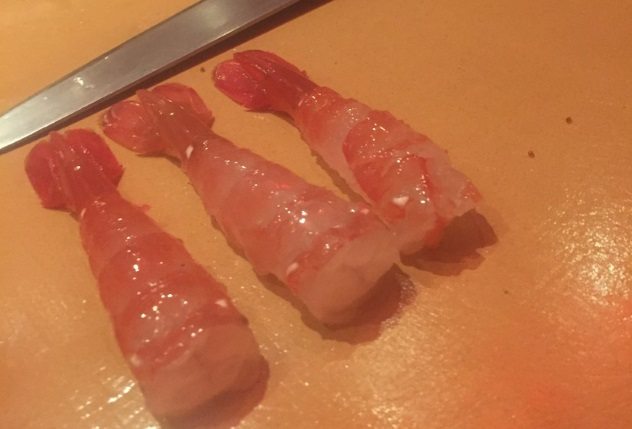
We’ve spoken before about the different types of live shrimp you can order in Japan or China, but if you’re living stateside and looking for something a little closer to home, just head on down to Slow Fish in the Miracle Mile district of Los Angeles.[4] Here, you can pick yourself up a portion of dancing shrimp, so called because of the way their legs, antennae, and body convulse when they are served.
The dish is prepared by chopping off the shrimps’ heads, removing the shells, and bringing them immediately to the diner. With both the bodies and the heads still moving, the main part of the shrimp is eaten straight away. The heads are then brought back to the kitchen, where they are deep-fried before being served again, this time motionless.
6 Lobster Sashimi
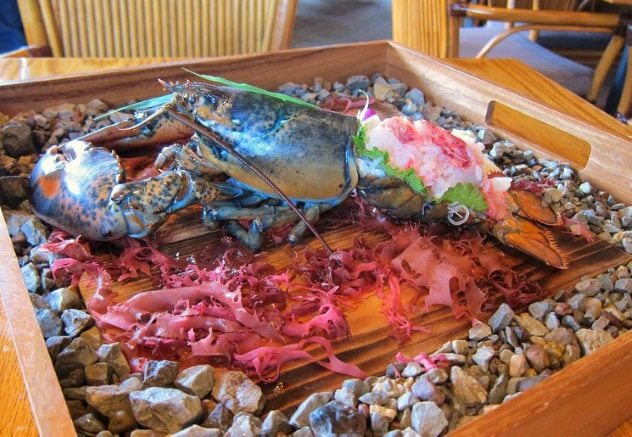
Despite all the evidence we have seen for the wide variety of unnecessarily cruel dishes around the world, lobster remains one of the most famously controversial dishes in Western society. The idea of picking them out and then placing them in water to be brought to boil just doesn’t sit well with some people. However you may feel about that practice, it has certainly overshadowed the controversy in how many other foods are prepared, including another lobster dish.
Sashimi is a Japanese dish where meat or fish, as fresh as humanly possible, is thinly sliced and served raw. And if you live in the Houston area, you can experience a lobster sashimi so fresh, it’s still moving.[5] The dish is made by cutting the lobster in half, scooping out the flesh in the back, slicing it, and putting it back in. With the back half of the lobster made into a little display, the dish is served on a bed of cold rocks, with the front half of the lobster struggling around for effect. One critic described the dish as “awe-inspiring” and “utterly delicious.”
5 Cockroaches
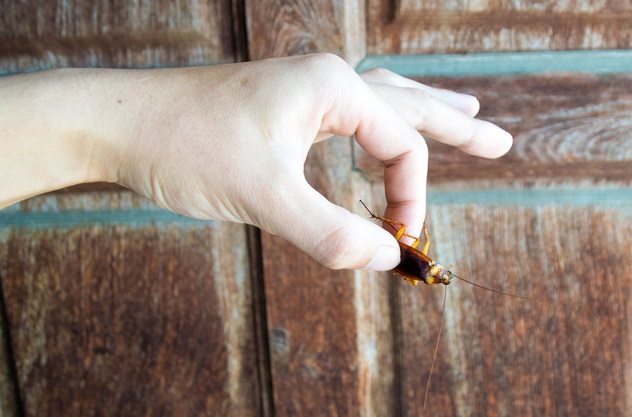
There have been many suggestions in recent years that thanks to skyrocketing global population figures, we may have to turn to eating insects to meet our demand for food. Certain insects are already a common snack in some countries, with celebrities like Salma Hayek admitting they adore the little creepy candies.
But while cooked bugs may be a good source of protein for some people, live cockroaches were intended to be a good source of pythons for others.[6] In 2012, over 30 people competed in a cockroach eating contest in Florida, where the winner would be rewarded with a new pet python. Unfortunately, the competition did not go well, and a 32-year-old participant choked to death as he reportedly ate dozens of the creatures.
4 Bats
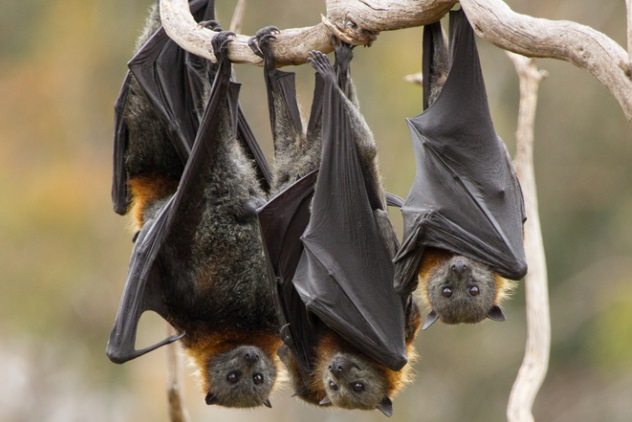
The Mariana flying fox is a species of fruit bat found on the Mariana Islands. Although they once numbered about 60,000, their population has dwindled to several hundred after decades of being hunted by humans. With thousands of them all over the islands, the bats soon became a reliable source of food for both humans and farm animals.
Usually reserved for special occasions, ka’ka’du fanihidu fanihi is a dish where the bat is caught and washed before being placed in a pot of boiling water.[7] It is then served whole in a bowl of coconut milk and eaten more or less in its entirety (save for bones and teeth).
But unlike most of the entries on this list, this dish is one that may actually be lethal. After World War II, scientists noticed that a large number of the residents of Guam were dying of a mystery illness. We now know that between a quarter and a third of were dying of ALS, which they were developing as a result of their batty diet. The bats feed mainly on cycad seeds, which results in high levels of dangerous toxins that can lead to ALS when consumed by humans in the long term. Fortunately and unfortunately, the bat population in Guam has dwindled so much that this is now, for the first time, a dying dish.
3 Eels
Raymond Blanc is a French chef who runs some of the most well-respected restaurants in Britain. As you might expect from a chef of his stature, Blanc has traveled the world and tried all sorts of rare and unusual dishes. Of these, he says the strangest meal he has ever eaten is a bowl of live eels.
Blanc says that while dining in Japan, a large glass bowl filled with thousands of tiny eels was brought to the table.[8] The bowl was placed in the middle of the table, and the eels would jump out, hopefully landing in your bowl. At less than an inch long, the eels are intended to be swallowed whole so you can experience them wriggling down your throat. Despite trying the dish himself, Blanc said it was an example of how “perverse” Japanese cuisine can get.
2 Cobra
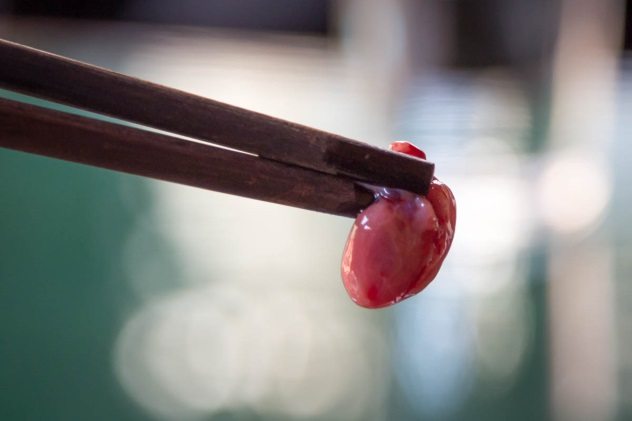
Whether you eat lobster or not, we’re all familiar with the tradition of customers choosing which lobster they want out of the tank. In Vietnam, diners can have a similar experience by choosing which cobra they want out of a cage of angry snakes.
When you have picked out your snake, the chef will grab it with a stick and throw it on the floor. They’ll usually antagonize the snakes as well, either by shaking the cage before you make your choice or poking your snake afterward. This is possibly done to make sure the snake’s heart beats faster to magnify your experience.
The snake will be sliced down the middle and held above a half-full glass of rice wine, allowing all the blood to drain into the wine.[9] The still-beating heart of the snake is then removed and put into the same drink, while the appetizing juices of the gallbladder are drained into a second glass of rice wine. The idea is that you down the first glass, beating heart and all, and follow it up with the second glass to cleanse your palate as the snake meat is taken away and made into slightly more normal dishes, such as spring rolls or soup.
1 Witchetty Grubs

It may seem unfair to include insects in a list made up primarily of more complex life-forms, but the size and ubiquity of these grubs warrants them a place. Encompassing the larvae of several different types of moths, witchetty grubs are native to Australia and have been a staple of the aboriginal diet for centuries. The grubs are high in protein and contain lots of other nutrients and vitamins, making them one of the best sources of food in the Outback.
Witchetty grubs can grow up to 12 centimeters (4.7 in) and are usually eaten live, in which case they have an almond taste and a gooey center.[10] However, they can also be lightly toasted either on a barbecue or in a mix of hot ash and sand, which is said to give them a chicken and fried egg taste.
You can follow Simon as he tweets living creatures.
For more atypical dining ideas, check out 10 Disgusting Delicacies From Around The World and 10 Bizarre Cultural Foods Guaranteed To Make You Lose Your Lunch.






![Top 10 Disgusting Foods The Chinese Eat [DISTURBING] Top 10 Disgusting Foods The Chinese Eat [DISTURBING]](https://listverse.com/wp-content/uploads/2020/03/23773182-0-image-a-46_1580303417295-150x150.jpg)
